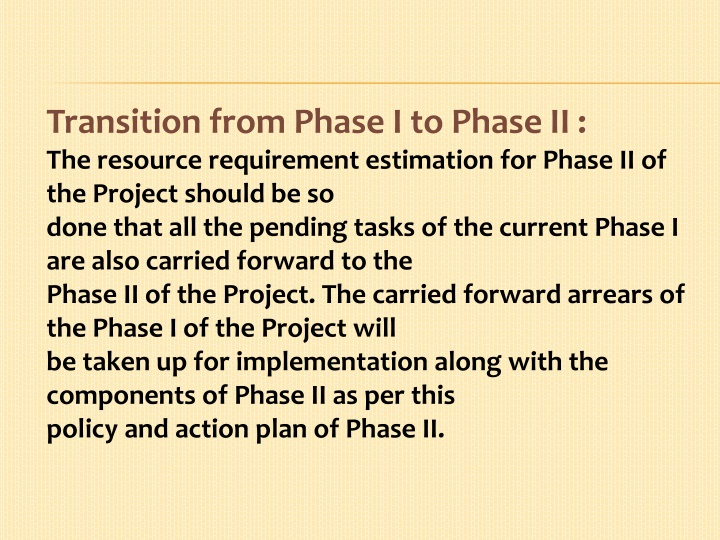
Efficient Transition and Resource Planning from Phase I to Phase II of Project
Ensure a seamless transition from Phase I to Phase II of the project by carrying forward pending tasks and arrears. The eCourts Project involves creating computer rooms, providing laptops and printers, ICT training, and more. Phase II focuses on additional courts, new hardware installations, LAN setup, WAN connectivity, and software deployment.
Download Presentation

Please find below an Image/Link to download the presentation.
The content on the website is provided AS IS for your information and personal use only. It may not be sold, licensed, or shared on other websites without obtaining consent from the author. If you encounter any issues during the download, it is possible that the publisher has removed the file from their server.
You are allowed to download the files provided on this website for personal or commercial use, subject to the condition that they are used lawfully. All files are the property of their respective owners.
The content on the website is provided AS IS for your information and personal use only. It may not be sold, licensed, or shared on other websites without obtaining consent from the author.
E N D
Presentation Transcript
Transition from Phase I to Phase II : The resource requirement estimation for Phase II of the Project should be so done that all the pending tasks of the current Phase I are also carried forward to the Phase II of the Project. The carried forward arrears of the Phase I of the Project will be taken up for implementation along with the components of Phase II as per this policy and action plan of Phase II.
Components of Phase-I of the eCourts Project Creation of Computer Room at all the Court Complexes/ Site. Laptops and Printers to Judicial Officers and Judges. ICT Training for Judicial Officers and Staff. Deployment of Technical Manpower. Computer Hardware (Servers, Clients, Printers, Scanners, Projectors etc.) in each Court Complexes. Installation of LAN (Local Area Network) in each Court Complex. Communication and Connectivity Internet connectivity to the Court Complexes. Power Backup through UPS.
Power Backup through UPS. Power Backup through DG set. Upgrading ICT infrastructure of High Court. Video Conferencing facility in High Court and District Courts. Development of Case Information Software (CIS). Process Reengineering. Creation and Up gradation of Centralized facility for System Administration. Project Management, Project Monitoring and Change Management System. System Software (UBUNTU O.S.) , Office Tools etc. Data entry. National Judicial Data Grid.
The eCommittee, Supreme Court of India has framed a Policy and Action plan document on Phase-II of the eCourts Project. As per the new Policy and Action Plan. The components to be continued are : Site Preparation for the new Court Complexes. Covering the Additional Courts that have been came up within the same Court Complex. Hardware (Computers & Thin Clients/ Laptops, Printers, Scanners, Projector with Screen, Kiosks, Display Units, Barcode Printers/ Scanners etc) installation in all the Court Complexes. LAN Installation in the new Court Complexes. Wide Area Network (WAN)- Last Mile Connectivity upto SWAN PoP through LeasedLine/Wimax/VSAT/MPLS(Multiprotocol Label Switching).
Creationof Case Records. Creation of JSC(Judicial Service Centre)- CFC (Centralized Filing Counter) at all the Court Complexes. Software Deployment in the new Court complexes. Laptops & Printers for Additional Judicial Officers. Provisioning of Video Conferencing facility between under trail prisoners and magistrate with video monitoring. Use of FOSS (Free and Open Source Solution) only in the Hardware provided and to be provided. Extension Duration of Phase-I and its impact on other ongoing/ pending tasks of Phase-I. Installation of Wireless Internet facility system in the High Court Complexes. Infrastructure upgradation for centralized facility. Manpower and training Scanning, Degitization, Storage, Retrieval & Digital preservation
Digital Archive of record room and library Management system. Workflow & Process Automation tools/ Measures and Judicial knowledge Management System (JKMS). Use of advanced ICT tools, intensive training, warehousing and mining tool customization to crystallize change management, Biometric facilities, Gateway interface with other agencies. Use of NIC Data centre (Augmentation of Resources for Courts). Other Cloud computing Resources at SDCs (State Data Centres) Power Backup through DG ( Diesel Generator) set.
Power Backup through UPS. Power Backup through Solar Energy. Judicial Process Re-engineering. Project Management & Monitoring. Digital Signature Tokens for all the Judicial Officers. Authentication devices for Process Servers etc. Provisioning of Contingency Funds.
